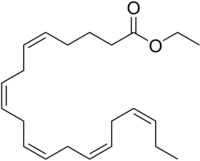
Photo from wikipedia
The omega-3 index, the percentage of EPA plus DHA in erythrocytes (measured by standardised analysis), represents a human body's status in EPA and DHA. An omega-3 index is measured in… Click to show full abstract
The omega-3 index, the percentage of EPA plus DHA in erythrocytes (measured by standardised analysis), represents a human body's status in EPA and DHA. An omega-3 index is measured in many laboratories around the world; however, even small differences in analytical methods entail large differences in results. Nevertheless, results are frequently related to the target range of 8–11 %, defined for the original and scientifically validated method (HS-Omega-3 Index®), raising ethical issues, and calling for standardisation. No human subject has an omega-3 index <2 %, indicating a vital minimum. Thus, the absence of EPA and DHA cannot be tested against presence. Moreover, clinical events correlate with levels, less with the dose of EPA and DHA, and the bioavailability of EPA and DHA varies inter-individually. Therefore, the effects of EPA and DHA are difficult to demonstrate using typical drug trial methods. Recent epidemiologic data further support the relevance of the omega-3 index in the cardiovascular field, since total mortality, cardiovascular mortality, cardiovascular events such as myocardial infarction or stroke, or blood pressure all correlate inversely with the omega-3 index. The omega-3 index directly correlates with complex brain functions. Compiling recent data supports the target range for the omega-3 index of 8–11 % in pregnancy. Many other potential applications have emerged. Some, but not all health issues mentioned have already been demonstrated to be improved by increasing intake of EPA and DHA. Increasing the omega-3 index into the target range of 8–11 % with individualised doses of toxin-free sources for EPA and DHA is tolerable and safe.
Journal Title: Proceedings of the Nutrition Society
Year Published: 2020
Link to full text (if available)
Share on Social Media: Sign Up to like & get
recommendations!